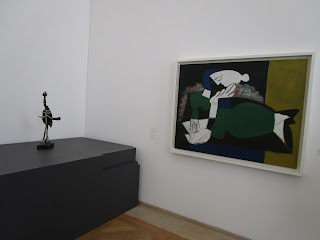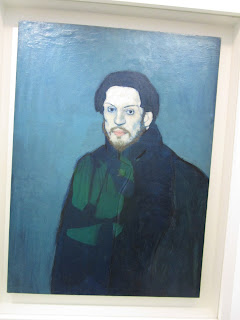 |
| The Burghers of Calais |
The first destination was the Musée Rodin, or the Rodin Museum. It's located right near Les Invalides, which is a complex of buildings housing what is supposed to be an excellent museum of French military history, as well as (supposedly) the tomb of Napoleon.
Let me think about whether I want to visit the Tomb of Napoleon:
The interior of the museum has the temporary exhibits. No Rodin. Bunch of modern multimedia [expletive]. No photography allowed inside. They don't want the word to get out that the rotating collection is inferior work by marginal talents. Like the arrangement of rocks on top of a wire cage under a bright light that casts a shadow in the shape of a rabbit. That one really competes with the Mona Lisa for tourist eyeballs,
The Rodin statues are all outside.
You know this guy. The Thinker. Only in Paris, this guy is called "Le Penseur".
You probably know who this guy is, although you may not recognize him:
This is the French writer Balzac. Rodin completely captures Balzac's haughtiness. Actually, I don't know if Balzac was haughty or not. But the statue certainly makes him look so.
This is Eve. Adam's wife. This is the moment where she has precipitated the fall. I'm guessing this is supposed to be the point where she becomes ashamed of her nakedness. And, no, Rodin did not call this work "Eve of Destruction."
Easy joke, I know. But I have to lighten the mood in preparation for this next work:
In the middle of this pool of water is the statue depicting Ugolino devouring his children. Dante's Inferno puts Count Ugolino in a fairly deep circle of hell. No surprise there. Ugolino was an actual Italian count from the 1200's who actually did eat the corpses of his children. Rodin incorporated this scene in his masterwork that was at the Pantheon in Paris's Latin Quarter: the Gates of Hell.
It looks much nicer from this angle with the museum building in the background.
However, this angle, with the Invalides dome in the background, still looks bad.
And this is Adam, which I'm guessing is a companion piece to the Eve we saw earlier.
This next one is from the Burghers of Calais:
The Burghers of Calais depicts six citizens of Calais who, during the Hundred Years' War (1337-1453) agreed to surrender themselves to King Edward III, presumably to be executed, in exchange for the English lifting the siege on the city. The garden area has six separate figures (most nude) that Rodin did in preparation for his great work. This is one if the more interesting figures up close and personal.
Parisian tourist meets statue.
Parisian tourists pose with figures from the Gates of Hell.
And here it is, the Gates of Hell from the Pantheon:
Look at the detail. This is the scene of Count Ugolino devouring his children.
I'm guessing these folks are trying to crawl their way out of hell. Bad news for them: being frozen in bronze means they will not make it out.
These are the three figures that are at the top of the Gate of Hell, much easier to see at ground level.
Unlike, for example, the Louvre, the Rodin was not exhausting. So time for another museum. Let's head across town for the Paris Picasso:
At the entrance to the Picasso Museum is the sculpture from Picasso: Man with Sheep. It's a perfectly nice work, but it illustrates a problem with this museum.
As does the Two Women here. This is a museum that is very heavy on the sculpture.
The sculpture from Picasso is interesting at times, such as the work above from his series of Absinthe Cups. But a museum of Picasso sculpture is like buying a CD of Celine Dion playing the cello. She might be a perfectly decent cellist, but Celine Dion was put on this planet to sing.
And Picasso was a painter who did the occasional sculpture. But there is very little painting in this Picasso museum.
Head of a Woman is nice.
So nice I selfied with her.
And these two show a certain creativity.
Even those, too. And these:
But when you see a Picasso sculpture placed next to one of his paintings:
It really emphasizes what is missing. This:
Picasso painting. This is a self-portrait from the Blue Period.
The museum is very new. But having been to the Picasso museum in Barcelona, which is an excellent museum for Picasso's early years, but leaves out the heart and soul and cubism of his most productive years, and now having been to the sculpture-heavy Picasso museum in Paris, I am wondering where there is a museum with a definitive collection of Picasso painting.
I did like Picasso's variations on Woman with a Hat. Given the identical pictures in differing colors, I'm wondering if this is what inspired Andy Warhol to do his silk screens of Marilyn Monroe, or Jackie Kennedy Onassis, or Mao, in varying colors.






























No comments:
Post a Comment